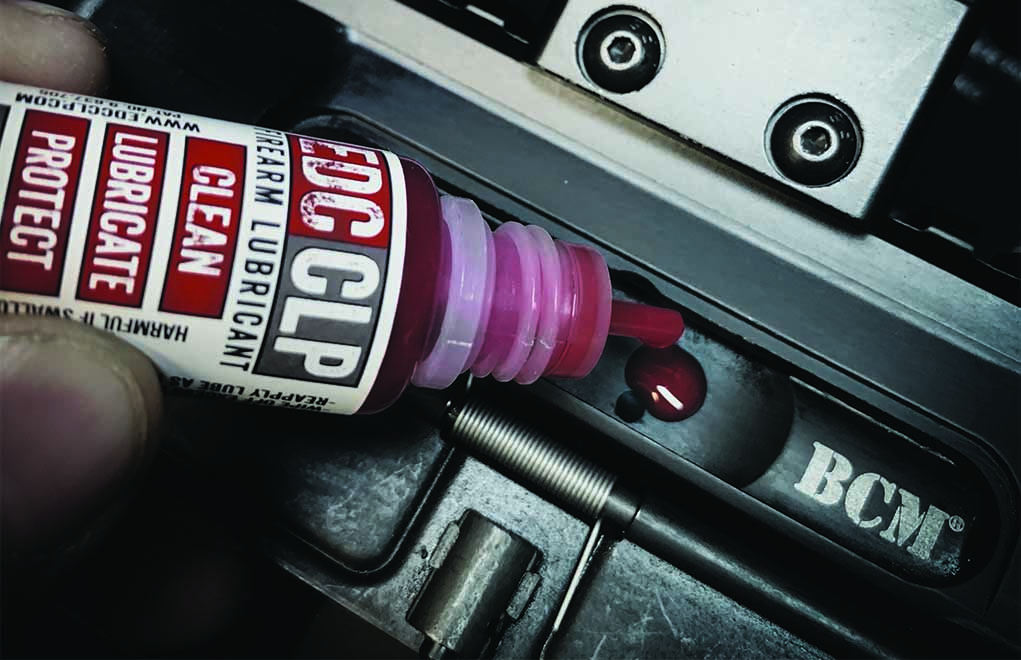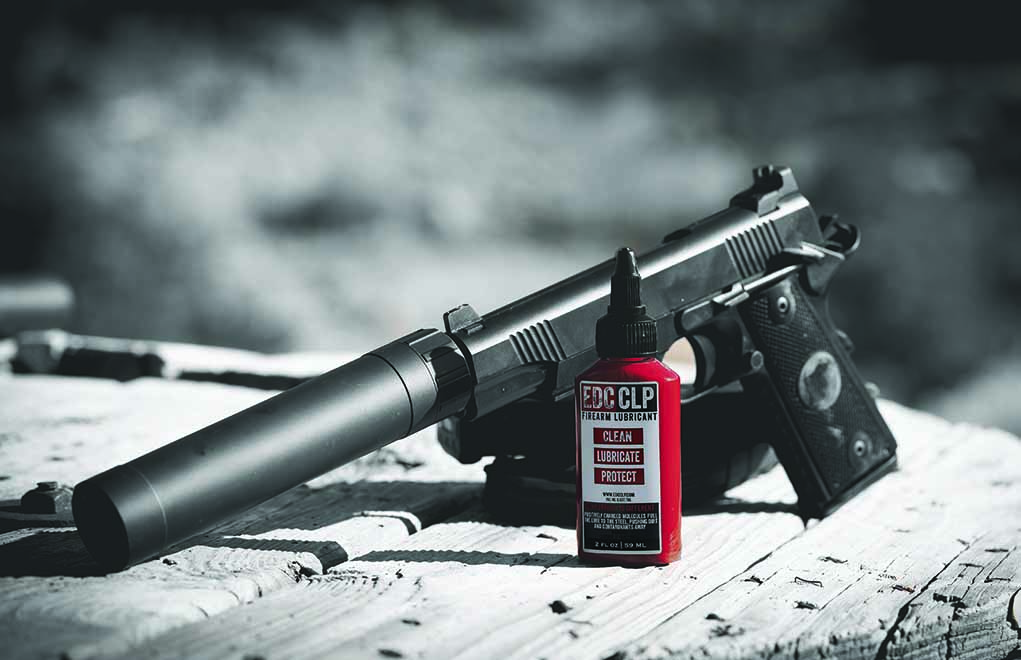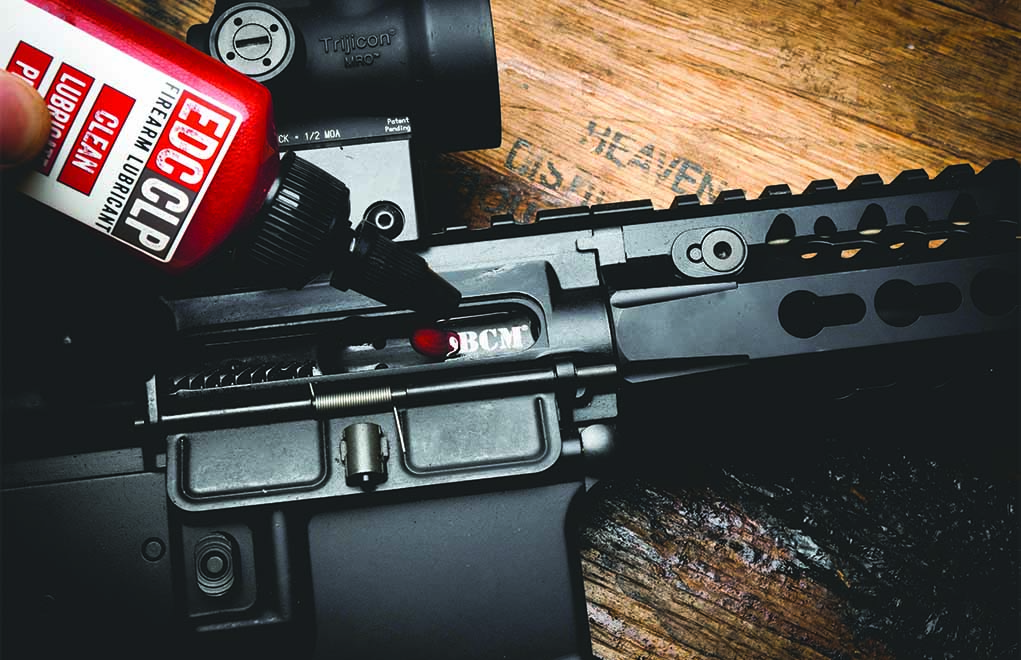https://gundigest.com/gear-ammo/accessories/gun-oil-what-modern-guns-require-to-fight-friction?By Patrick Sweeney -April 14, 2021
Does your gun oil bring out the best in your firearms?When was the last time you gave as much attention to your gun oil as your ammunition, magazines, optics or lights? Because lube can’t attach to a Picatinny rail, get laser-etched or dipped in the latest absolute invisibility camo pattern, probably very little.
When was the last time you considered what’s in your lubricant and how that impacts the performance of your firearm? Probably the same answer.
100-Year-Old LubricantSadly, many American firearm owners lubricate their guns with “what they’ve always used” and live with its shortcomings. In fact, the top-selling gun oil in the United States was introduced in 1913—before World War I! It was designed first and foremost to prevent rust; lubrication was a distant second, and cleaning only happened with aggressive scraping and additional harsh chemicals.

Used more broadly today than at any time in history, a suppressor’s downsides comprise the extra gases and heat channeled back through the action. How does your typical lubricant hold up when you’re running a can?
However, this historical “blindness” isn’t without cause: Until the end of the 20th century, the single greatest enemy to carbon-steel and wood firearms was rust. The cleaning process for firearms of this era required harsh chemicals and often hours of scraping that put excessive wear on internal components. But, it had to be done: Rust was every gun’s “public enemy number one.”
Worse, neither the firearm’s function nor its reliability was materially improved by this method or lubrication. Not only were gun owners fighting a losing war against the ravages of rust, but also against heat, friction and chemistry.
Modern Performance and Reliability EnemiesToday, rust isn’t the threat it once was. Most modern firearms are made from a combination of synthetic materials, stainless steel or coated metals. But, along with modern materials come gas-operated designs with smaller, faster-moving parts and tight tolerances. Today, friction, heat and compounded contamination are the modern enemies to reliability and performance.
Why? The same gases used to propel the bullets and cycle actions carry contaminants around—and into—every angle and crevice of your firearm. Driven by heat and pressure, these gases bake layer after layer of carbon onto moving parts and into gas ports. Eventually, the layers build up and change the parts’ geometry. The contaminated parts can no longer move within or past one another, and function slows … or ceases outright.
For the modern firearm powered by its own gases, staying lubricated under heat, pressure and friction—and fighting carbon buildup—is critical. More importantly, how quickly can you remove the unavoidable contamination from the parts and get your AR reliably back into action?

For the modern firearm powered by its own gases, staying lubricated under heat, pressure and friction—and fighting carbon buildup—is critical. More importantly, how quickly can you remove the unavoidable contamination from the parts and get your AR reliably back into action?
The historical solution, often sold as a “character-builder” by generations of drill sergeants, is to scrape parts with metal tools, chemicals, picks and brushes to remove every visible fragment of carbon. This approach damages the parts with each cleaning, often to the point of failure—or, if an armorer is lucky, deemed “out of spec”—and replaced.
This self-defeating process is separate from the excessive time wasted for such a laborious process that just about any reasonable person would rather spend doing something else … such as shooting.
So, if modern firearms require a different lubricant solution to support their unique functional requirements and materials, what should it contain?
* A high-quality synthetic lubricant base capable of enduring the high heat and pressures of modern firearms without breaking down, being displaced by water or gelling in low temperatures, along with a rust-prevention additive.
* A penetrant to reach the micro-crevices between small parts that can become clogged with contamination.
* A detergent to clean the moving parts and bearing surfaces while the weapon functions, yet is still safe on synthetic materials and finishes.
* A dispersant to prevent the contamination from re-adhering to the metal, particularly under heat and pressure.
Functionally, a modern gun oil should also speed cleaning and lengthen the amount of time between required cleanings. This element is particularly important if you’re serving in an austere environment in which a reliably functioning firearm could determine your ability to defend yourself from harm.

Today, while rust is a factor any quality lubricant should inhibit, the contamination buildup in the bolt carrier group can change the geometry of the parts and lead to failure.
Today, while rust is a factor any quality lubricant should inhibit, the contamination buildup in the bolt carrier group can change the geometry of the parts and lead to failure.
Ask yourself: If you had two identical firearms you carried and utilized daily, wouldn’t the more reliable of the two be the one with a lubricant that functioned consistently and for more extended periods under heavy use, yet was easier to clean? Viewed in a military context, isn’t the ability to stay in the fight longer and be cleaned quickly also a significant tactical advantage?
Modern Gun OilOne recent entrant to the market—born on a poncho at Fort Benning, Georgia, amidst an array of AR parts, picks, brushes, patches and issued chemicals—might’ve cracked the code.
Created with modern firearms and their needs in mind, EDC-CLP’s patented chemical components not only continue to clean and lubricate for extended periods under excessive heat and pressure, they also reach into the micro-crevices contaminated with baked-on carbon that picks and brushes cannot reach.
One key addition to the formulation is a “high-pressure additive” with positively charged molecules that adhere to the metal. In other words: It keeps the product in and on the parts—cleaning and lubricating—during use, rather than being forced off by friction and gases. The high-pressure additive also provides the added benefit of suspending the contamination in the lubricant that the dispersant and detergent elements slough loose from the parts.
How does it perform outside the chemistry lab?EDC-CLP’s positive impact on your gun’s function is both immediate and gradual. After a single application, a user will feel an instant improvement in lubricity (slipperiness). In most cases, follow-up cleaning requires little more than a wipe-down and reapplication.
EDC-CLP doesn’t require special preparation of the weapon’s parts in a sterile environment in order to work. It can be applied on top of existing gun oils or lubricants if necessary.
So, ask yourself, Which “war” is your lubricant fighting?
For more information on ELC-CLP Lubricant, please visit edcclp.com.
Editor's Note: This article originally appeared in the 2021 Long-Range Shooting issue of Gun Digest the Magazine.